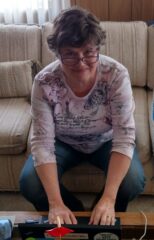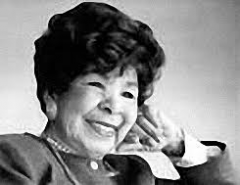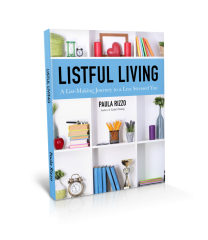by Nita Sweeney, award-winning author of Depression Hates a Moving Target and coauthor of You Should Be Writing
You’ve heard of the “To Do” list, but what about the “To Write” list? It can be a powerful tool in your writing kit.
• The Back of the Writing Journal
 I learned about “To Write” lists from best-selling author Natalie Goldberg, of Writing Down the Bones fame. As I sat in the classroom at Mabel Dodge Luhan House in Taos, New Mexico, I watched her pick up her writing journal, flip to the back, and show us a list of scrawled topics she’d penned on the final page. She carried a notebook everywhere and jotted ideas on the back page as they occurred to her. “If I’m stuck, I look at these,” she said.
I learned about “To Write” lists from best-selling author Natalie Goldberg, of Writing Down the Bones fame. As I sat in the classroom at Mabel Dodge Luhan House in Taos, New Mexico, I watched her pick up her writing journal, flip to the back, and show us a list of scrawled topics she’d penned on the final page. She carried a notebook everywhere and jotted ideas on the back page as they occurred to her. “If I’m stuck, I look at these,” she said.
While I’d read about these lists in Natalie’s books, to see the real thing left quite an impression.
I began to do as she did and still carry a notebook at all times. When I’m at a loss for a writing topic, I flip to the back, pick one, and go!
• List-Making Exercises
But what really stuck with me were the list-making exercises Natalie led.
In her strong Brooklyn accent, Nat might say, “Tell me every lunch you’ve ever eaten. Ten minutes. Go!” Off we would jump, deep into the pages of our writing journals, pens flying as we wrote about chicken cordon bleu, pasta primavera, and French fries with ketchup.
To the fiction writers, she suggested writing these lists from the point of view of a character. “Tell me everything Hester Prynne ever ate.”
The topics Natalie offered varied, but here are a few of my favorites:
- The things I carry (a spin-off from The Things They Carried by Tim O’Brien).
- Write the name of every place you’ve ever been
- List every member of your family
- Make a list of everyone you’ve ever met
- Write the names of all your pets
- Describe every car you’ve ever owned and tell what happened to it
- Write a list of every home in which you have lived
- List all your loves
- Tell me everything you know about the color blue (or the sky or a rock)
• Now Dive!
In the next writing session, Natalie would ask us to choose one thing from our list and drop into that.
“Go as deep as you can,” she would say, reminding us that specificity and sensory detail is key to painting a picture in the reader’s mind.
• Be Flexible
When you begin, you might fill your allotted writing time with the list itself. But as you grow more comfortable with the list-making process, you might allow your mind to naturally land on one thing, perhaps related to your current project, and delve into that. Either method works.
• Priming the Pump
The point of these exercises is to bypass the anxiety many writers face. Call it writer’s block or procrastination or sheer terror. Regardless of the name, the solution is the same—get the pen moving.
Making a list tricks that part of the mind that fears writing is too complicated or exhausting into just starting. It primes the pump. You begin by jotting down “Fido, Rover, and Spot,” and before your brain has time to panic, you’re writing about how your mother carried three black and white rat terrier puppies in a wicker basket around your family farm.
• Other Benefits
Even if you don’t face the dreaded writing paralysis, list-making can help you access new material or provide insight on subjects you thought you had already covered in detail. Any new angle to enter the mind will prove useful.
Do you use “To Write” lists? I’d love to hear how they work for you!
An earlier version of this post appeared on Nita’s blog, Bum Glue.
 Nita Sweeney is co-author with Brenda Knight of the writing journal, You Should Be Writing: A Journal of Inspiration and Instruction to Keep Your Pen Moving. Nita’s running and mental health memoir, Depression Hates a Moving Target: How Running with My Dog Brought Me Back from the Brink, won the Dog Writers Association of America Award in the Human/Animal Bond and was short-listed for the William Faulkner—William Wisdom Creative Writing Competition Award. Nita’s articles, essays, and poetry have appeared in many magazines, journals, books, and blogs. She writes her own blog, Bum Glue, publishes the monthly e-newsletter, Write Now Columbus, and coaches creatives on writing and meditation in Natalie Goldberg style “writing practice.” Nita has been featured widely across media outlets about writing, running, meditation, mental health, and pet care. When she’s not writing or coaching, Nita runs and races. She has completed three full marathons, twenty-seven half marathons (in eighteen states), and more than one hundred shorter races. She lives in central Ohio with her husband and biggest fan, Ed, and their yellow Labrador running partner, Scarlet, the #ninetyninepercentgooddog. You can contact Nita via her website or follow her on your favorite social media channel.
Nita Sweeney is co-author with Brenda Knight of the writing journal, You Should Be Writing: A Journal of Inspiration and Instruction to Keep Your Pen Moving. Nita’s running and mental health memoir, Depression Hates a Moving Target: How Running with My Dog Brought Me Back from the Brink, won the Dog Writers Association of America Award in the Human/Animal Bond and was short-listed for the William Faulkner—William Wisdom Creative Writing Competition Award. Nita’s articles, essays, and poetry have appeared in many magazines, journals, books, and blogs. She writes her own blog, Bum Glue, publishes the monthly e-newsletter, Write Now Columbus, and coaches creatives on writing and meditation in Natalie Goldberg style “writing practice.” Nita has been featured widely across media outlets about writing, running, meditation, mental health, and pet care. When she’s not writing or coaching, Nita runs and races. She has completed three full marathons, twenty-seven half marathons (in eighteen states), and more than one hundred shorter races. She lives in central Ohio with her husband and biggest fan, Ed, and their yellow Labrador running partner, Scarlet, the #ninetyninepercentgooddog. You can contact Nita via her website or follow her on your favorite social media channel.


 Ms. Morris was the first Coordinator of Children’s Services at the San Francisco Public Library and established the Children’s Historical and Research Collection at the Children’s Center of the San Francisco Library. She went on to become the first African American president of the Public Library Association. In 1968, Ms. Morris founded the San Francisco Chapter of the Women’s National Book Association, which began in 1917. The WNBA SF Chapter is continuing our advocacy for the voices of women and diverse authors in tribute to Ms. Morris’s important work and legacy.
Ms. Morris was the first Coordinator of Children’s Services at the San Francisco Public Library and established the Children’s Historical and Research Collection at the Children’s Center of the San Francisco Library. She went on to become the first African American president of the Public Library Association. In 1968, Ms. Morris founded the San Francisco Chapter of the Women’s National Book Association, which began in 1917. The WNBA SF Chapter is continuing our advocacy for the voices of women and diverse authors in tribute to Ms. Morris’s important work and legacy.



 My website is hosted by WIX and I have to be honest…if asked, I would happily do a promotional spot for WIX’s stellar customer service. Beyond great customer service, they have a marketing tool that allows users to create beautiful quote graphics that can be posted on all social media platforms. The picture is an example of one of my favorites that was made through my website.
My website is hosted by WIX and I have to be honest…if asked, I would happily do a promotional spot for WIX’s stellar customer service. Beyond great customer service, they have a marketing tool that allows users to create beautiful quote graphics that can be posted on all social media platforms. The picture is an example of one of my favorites that was made through my website.
 The fabulous
The fabulous 
